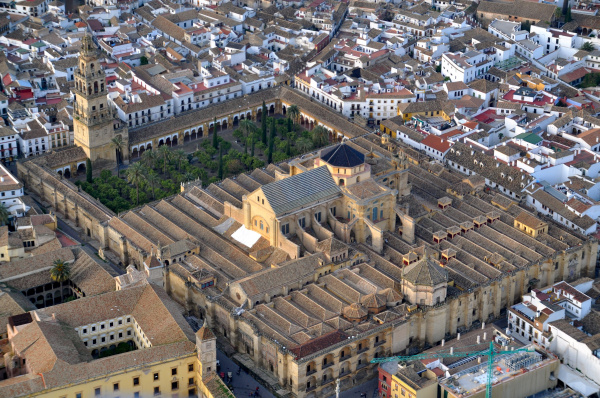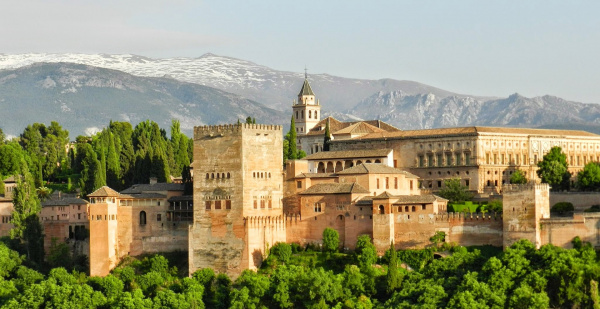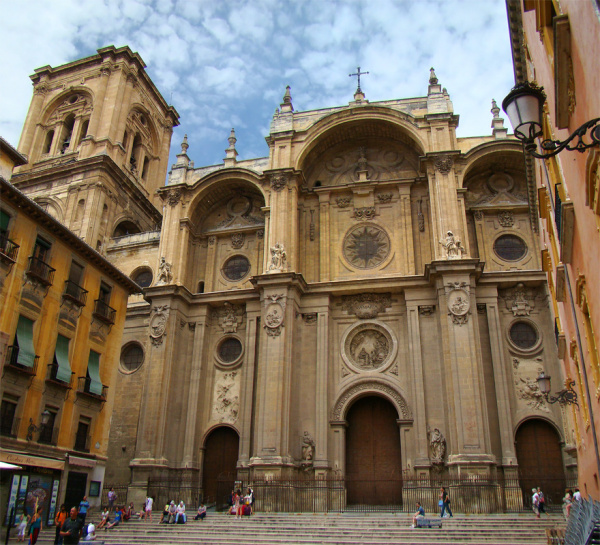Islamic architecture in Spain has left a remarkable heritage, reflecting the rich history of the period of Arab rule in the Iberian Peninsula. From the VIII to XV centuries, Arab Islamic culture flourished in Spain, bringing with it exquisite architectural traditions that continue to inspire contemporary architects.
Cordoba Cathedral

Toni Castillo Quero/Creative Commons 2.0
One of the most famous examples of Islamic architecture in Spain is the Cathedral of Cordoba, also known as the Mosque-Cathedral of Cordoba or Mehmed Mosque. It was laid out in the VIII century and rebuilt in the XII century in the Arab style of the Muslim Spanish Caliphate. The building’s peculiarity is its hypnotic forest of pillars with double arches, giving the impression of infinity and harmony. This amazing complex synthesizes Arab and Christian styles, reflecting centuries-old history of this place.
The Cathedral of Cordoba was built on the site of the former Christian Basilica of the Holy Eighteen Wise Men. After the Muslim Arabs conquered Cordoba in 711, they turned the church into a mosque. By the early XIX century, the building became too small for the rapidly growing Muslim population, and Emir Abd al-Rahman I (756-788) ordered a new mosque to be built on the site.
In 784, the construction of the Cordoba Cathedral began, which was designed by great architect and engineer Abdallah ibn Baqer. The construction took over 200 years and was completed in 987, when Caliph Hisham II (961-976) added the central section of the mosque and expanded the complex.
The Cathedral of Cordoba is a unique combination of Arab and Christian architecture. The main space of the building, which is called haram, epitomizes the sophistication and simplicity of Islamic architecture. It contains over a thousand columns supporting fifty-two double arches that give the impression of a forest of pillars. Each of the arches is decorated with rich ornamentation.
However, after the Reconquista, the restoration of Christian rule over Spain in the XV century, the Cathedral of Cordoba was transformed into a Christian temple. In 1523, during the rule of Charles V, a Catholic altar and Christian chapels were built inside the mosque, as well as a partition separating the Christian and Muslim parts of the building.
There are many legends associated with the cathedral. Among others, there is the one about the place under the minaret of the mosque, known as the Devil’s Well. According to the legend, the devil hides here, trying to find the nest of a dove with an olive branch – a symbol of peace. If he finds this nest, peace will come to an end. This legend forever attracts the curiosity of visitors who come to see this mystical place.
The Cathedral of Cordoba continues to attract thousands of tourists around the world, drawing them in with its unique cultural and historical heritage. It is a symbol of a centuries-old mixture of cultures and religions, making it a significant historical place and architectural masterpiece.
Alhambra

Pablo Valerio/Pixabay
Another fine example of Islamic architecture in Spain is the Alhambra, located in Granada. This complex of palaces and gardens was built in the XIII-XIV centuries by the rulers of the Nasrid dynasty. The Alhambra is the epitome of art and harmony. Its chambers, arches and fountains reflect the cultural influences of Muslim and Christian traditions.
The Alhambra is one of the most visited tourist attractions of the country.
The history of the Alhambra dates back to the IX century when Emir Mohammed I began building a fortress on Sabika Hill, with a magnificent view of Granada and the Sierra Nevada Mountains. Later, Emir Yusuf I (1333-1354) began the construction of palace halls and towers, and his son Mohammed V (1354-1391) significantly expanded the complex, giving it luxury and beauty.
The Alhambra reached its heyday during the reign of the last Muslim ruler of Spain – Emir Boabdil (1482-1492). He built the Lion Palace and completed the Citadel, which was famous for its defense system.
Curious stories and legends surround the Alhambra. One of them is associated with the name of the complex. It is believed that the word Alhambra comes from the Arabic word الْحَمْرَاء (Al Hamra), meaning Red, and is related to the color of the red stone used in its construction.
Another interesting legend is connected with the Fountain of Tears. According to it, when Emir Boabdil surrendered the Alhambra and Granada to King Ferdinand and Queen Isabella after the end of the Reconquista, he turned to his native land and shed bitter tears. The fountain of tears came to symbolize his sad parting with this wonderful place.
However, despite the impact of historical events, the Alhambra has proved to be a surviving masterpiece of Arab architecture and design. The complex comprises several palace halls with exquisite decorations such as wood carving, stucco and mosaics, which together create impressive harmony.
The Alhambra is a vivid testament to the long history of cultural mixing on the Iberian Peninsula. Today it continues to attract tourists and art historians who come to see this unique and beautiful monument of Islamic architecture and get inspired by its beauty and elegance.
St. Mary’s Cathedral in Granada

Tango7174/Creative Commons 4.0
Islamic architecture in Spain also influenced the Cathedral of Granada. After the Catholic monarchs conquered Granada in the XV century, they decided to keep the Arabic elements and add Christian decorations. The result was St. Mary’s Cathedral in Granada, which combined the two styles and symbolized the transitional period between the Islamic and Christian rule.
St. Mary’s Cathedral in Granada, also known as the Cathedral of Granada, is the most important Christian church in this city and one of the most remarkable architectural masterpieces in Spain. It was built on the site of the former mosque built in the VIII century by the Muslim ruler of Granada. After the conquest of Granada in 1492, which ended the Reconquista period in which Spain restored Christian rule throughout its territory, Catholic monarchs Ferdinand and Isabella decided to keep some Arab elements of the building and add Christian decorations.
The construction of the cathedral began in 1523 and lasted about 181 years, finishing in 1704.
One of the curious stories associated with St. Mary’s cathedral is how Catholic monarchs Ferdinand and Isabella decided to build it. According to the legend, as the royal couple was looking at the ruined mosque, they were sitting on the hill of Albaicin and decided to build a Christian church when they heard a nightingale singing. They considered it to be a sign from above.
Inside St. Mary’s Cathedral one can find architectural diversity, combining Renaissance, Gothic and Baroque styles. The building is known for its beautiful stained glass windows and marble decorations. Particularly impressive is the main altar, designed in the Baroque style and decorated with numerous sculptures and artworks.
St. Mary’s cathedral is also famous for its royal chapels, where monarchs Ferdinand and Isabella and some members of their family are buried. These chapels are unique architectural masterpieces with beautiful wooden carvings.
Islamic architecture in Spain has left an indelible mark, becoming part of its cultural heritage. These magnificent buildings recall the centuries-old history of the multinational and multicultural Spanish people. Echoes of the past continue to inspire and fascinate lovers of art and architecture around the world.
GSV "Russia - Islamic world"
Photo in slider: FDominec/Creative Commons 4.0
